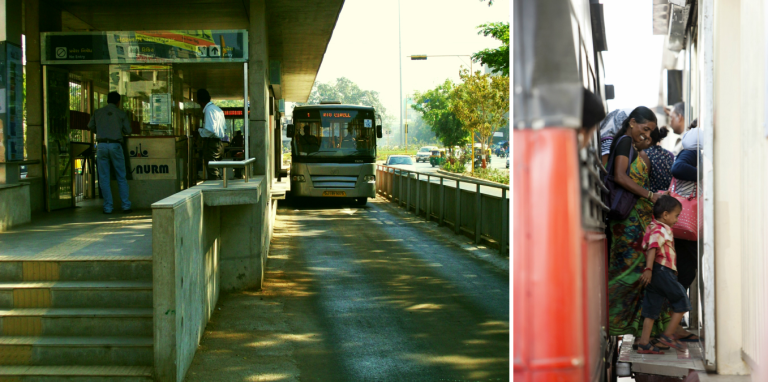The start of the BRT chapter in India can be traced to the announcement of the National Urban Transport Policy in 2006 by the Government of India. During this phase, the government received many applications for funding BRT projects.
Written by unknown
Written by unknown
The cities of Delhi and Pune were the first to start pilot BRT projects in the country, with plans for 257 km and 100 km networks respectively. But with only 5 km operational in Delhi and 15 km in Pune, both these systems were limited in scope and were heavily criticised for their poor quality of implementation. Perceiving BRT merely as a modified bus lane meant that these pilots did not address the need for BRT-specific service plans, integration with existing bus operations. The need for supporting infrastructure and enforcement measures were also ignored.
Janmarg paves the way for a new phase of BRT in India
In 2009, a new phase of high quality, bus rapid transit systems in India started with the implementation of Janmarg in Ahmedabad. From its initial operational length of 12.5 km, the system was expanded to an 88 km network in 2014, providing connectivity across the city. The success of Janmarg inspired similar BRT efforts like Rajmarg (Rajkot) in 2012, iBus (Indore) in 2013 and Citilink (Surat) in 2014.
More recently, another successful BRT system–known as Rainbow BRT–was implemented in the twin cities of Pune and Pimpri Chinchwad. These cities, assisted by ITDP, carried out various studies to understand existing ridership, daily travel patterns, passenger transfers, and waiting times on potential corridors to create a service plan that optimized system operations. Based on findings from these surveys, the cities decided to create a hybrid system with BRT services operating on dedicated trunk line, and then extending in mixed traffic to outlying areas. The cities also worked on rationalizing the routes of the public bus service, to efficiently complement the BRT system.
Key features of BRT
Whether it is Janmarg or Rainbow, new BRT systems in India are characterized by better infrastructure design and administrative structures that ensure smooth operations. Median-aligned stations with level-boarding ensure the system is accessible to all users. Intersection designs that prioritise BRT buses also help in improving bus speeds. Better enforcement ensures that the BRT corridors are reserved exclusively for BRT buses. To cater to rising demand, many of these systems also have overtaking lanes at stations, to allow for express services.

Dedicated right of way for buses with median-aligned stations (left) and level boarding(right) are some of the physical characteristics of the new phase of BRT systems.
Hybrid systems, such as the Rainbow BRT, feature high quality buses with doors on both sides, to cater both to median-aligned stations within the dedicated BRT corridors, as well as left-aligned bus stops outside the dedicated corridor. Better buses, such as the Euro IV CNG buses used in Rainbow BRT, help minimise carbon footprint of these systems. All buses are fit with GPS that allows monitoring by the central control centres, ensuring reliable service.
Clean, well designed stations offer a comfortable means of travel for the commuters. Clear branding coupled with real time passenger information systems help commuters in perceiving these systems as a high quality transit options that are different from regular bus services.
All these features contribute to make BRT a reliable means of commute in Indian cities. Both Janmarg and Rainbow have touched daily ridership numbers of 150,000, and have encouraged mode shift from private transport to BRT. In the case of Janmarg, studies indicate that 19% of private vehicle users have shifted to BRT. Rainbow BRT saw 8% of private vehicle users shift to BRT within 3 months of operations.
Cities are increasingly realising that they cannot increase road capacity by adding road space in the form of flyovers and elevated roads. With a focus on moving people rather than vehicles, cities are prioritizing sustainable mass rapid transport modes. This new paradigm, coupled with the realization that bus rapid transit systems can increase capacity at a lesser cost, makes the future of BRT in India undoubtedly bright.
This article is adapted from a webinar on ‘BRT in India’, presented by ITDP on 31 March, as part of the monthly webinar series hosted by The Across Latitudes and Cultures BRT Centre of Excellence. The presentation was followed by an interactive session where participants discussed various topics relating to fare collection, integration of BRT with other systems, data analysis etc. Watch the webinar below.
This infographic highlights the key features of BRT essential to any BRT system.
For quick understanding of the key features of BRT, download ITDP’s BRT standard infographic or to delve through the details in the BRT standard guide book.
